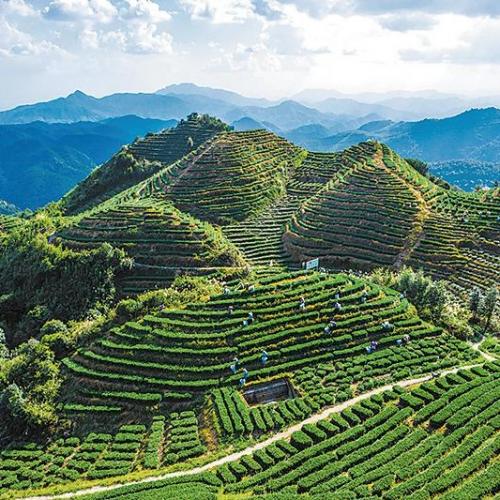



As tea is being produced in East China's Fujian province, two remote sensing satellites in orbit are busy monitoring the planting and maintenance of the crops.
The satellites, both launched in 2022, can obtain images with a resolution higher than half a meter and a width of 15 kilometers. They serve the tea-producing area in Anxi county, Fujian, which is famous for its tea industry.
The output value of the province's whole tea industry chain exceeded 150 billion yuan ($21.1 billion) in 2022, while its tea exports exceeded 3.5 billion yuan. Both ranked first in the country.
With a tea plantation area of about 240,667 hectares, the province achieved a raw tea output of 520,000 metric tons in 2022.
In order to drive intelligent tea production, Fujian has applied remote sensing to provide accurate data analysis and services for tea planting, processing and sales.
Using remote sensing images, technicians have combined meteorological, soil, agricultural and hydrological data. With this information, the satellites have created a digital database with indexes on subjects such as elevation, slope, accumulated temperature and precipitation, said Wei Leichen, deputy general manager of Satellite Link Bridge, one of the developers of the two satellites.
Satellite remote sensing is capable of monitoring a large area obtaining key information that is crucial for tea farmers, including disease, pests, soil moisture and nutrients in real time.
Conversely, the collection of remote sensing data also requires tea farmers to provide relevant data such as how their tea gardens are fertilized. Such interactions have made monitoring more efficient and comprehensive, according to Wei.
In addition to the tea industry, the remote sensing data from the two satellites have been applied in other fields such as agriculture, forestry, land, meteorology and environmental protection in Fujian.
Remote sensing technology improves the yield and quality of crops, reduces production costs and plays a key role in facilitating the sustainable development of agriculture and in reducing carbon emissions, Wei said.
"The emissions of the tea industry mainly come from tea gardens, especially excessive nitrogen fertilizer and soil acidification, product processing, distribution and consumption," said Gao Shuilian, an associate professor at Fujian Agriculture and Forestry University.
The province has implemented precise and improved fertilization methods on its tea fields.
Liao Hong, an agronomist at Fujian Agriculture and Forestry University, started promoting eco-friendly tea farms in the Wuyi Mountains in the province in 2018. Her team found the perennial planting of tea trees consumed excessive soil nutrients and caused soil degradation.
To improve the quality of both soil and tea, they proposed an eco-friendly approach featuring interplanting tea with soybeans in summer and rapeseed in winter.
Phosphorus and potassium, released from the soil during the cultivation of rapeseed, return to the field after flowering and it improves soil fertility. After spring tea is collected, soybean is interplanted between the plots to provide more nitrogen and promote green fertilization.
In addition, Anxi county has built a carbon footprint monitoring system for tieguanyin, the best oolong tea variety produced there, Lin Liyan, head of the county's science and technology bureau, was quoted by Science and Technology Daily as saying. Lin added that the green development method, with low energy consumption, low pollution and low emissions, has taken shape in the county's tea industry.
Lan Siren, president of the Fujian Agriculture and Forestry University, suggested deepening the integration of big data, photoelectric information, digital economy and tea industry and beefing up its green development.
Xinhua
If you have any problems with this article, please contact us at app@chinadaily.com.cn and we'll immediately get back to you.